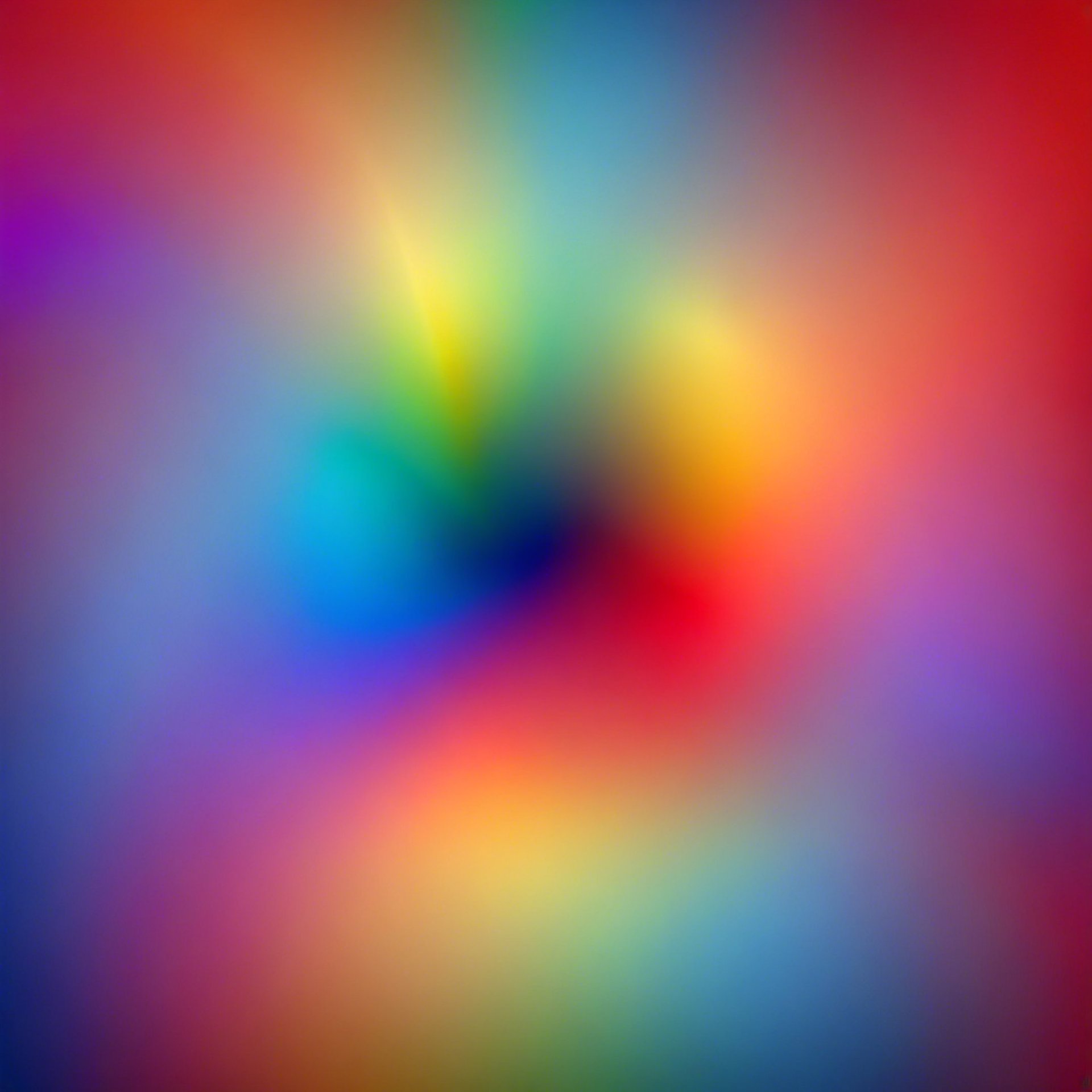
Unlock Your Musical Potential
Our Circle of Fifths Songwriting Tool helps you dive into Music Theory with ease and creativity. Introducing the Circle Of Fifths Music Theory Songwriting Tool & Chord Wheel
To create major and minor diatonic scales, we start with the chromatic scale, which consists of all 12 half-steps ( a.k.a semitones ) within an octave.
Think of the chromatic scale as the "Musical Alphabet"
It consists of the following Notes:
A, A#/Bb, B, C, C#/Db, D, D#/Eb, E, F, F#/Gb, G, G#/Ab.
( Note 1. the sharp of one note is the same tone as the flat of the next note that follows. these are called enharmonic equivalents )
( Note 2. while there is a whole step or whole tone between most "natural" notes in the scale, this is not true for B -> C, or E -> F )
If the Chromatic Scale is the Musical Alphabet, then Chords are the "words" built using notes from the Scale.
Songs, Riffs, Licks, Leads, Vocal Melodies, and all other Compositions are written using this "Musical Language"
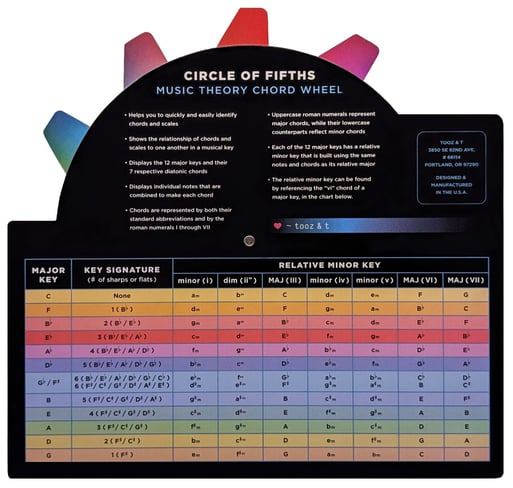

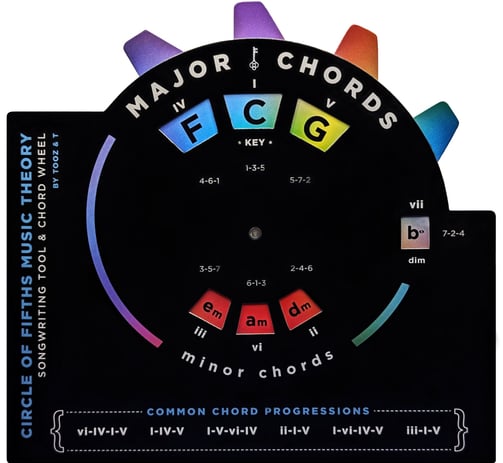

For a Minor diatonic Scale
( note: natural / relative minor )
the pattern is:
W-H-W-W-H-W-W (W = whole step, H = half step)
or using Tones & Semitones :
T-S-T-T-S-T-T ( T = whole tone, S = semitone )
To find the relative / natural minor of the C Major Scale we defined above, we start on the ( A ) , as it is the Sixth Scale Degree of this scale.
A (WHOLE STEP) B (HALF STEP) C (WHOLE STEP) D (WHOLE STEP) E (HALF STEP) F (WHOLE STEP) G (WHOLE STEP) A
This results in the A minor scale: A, B, C, D, E, F, G.


A diatonic scale is a 7-note scale that can be either major or minor.
To create a major or minor diatonic scale, we use a specific pattern of whole and half steps.
For a Major diatonic Scale, the pattern is:
W-W-H-W-W-W-H (W = whole step, H = half step)
or using Tones & Semitones :
T-T-S-T-T-T-S ( T = whole tone, S = semitone )
For example, to create the C major scale, Start on C :
C (WHOLE STEP) D (WHOLE STEP) E (HALF STEP) F (WHOLE STEP) G (WHOLE STEP) A (WHOLE STEP) B (HALF STEP) C
This results in the C major scale: C, D, E, F, G, A, B.


Notice anything interesting ?
Both of these scales were created by starting with a different note and using different patterns, but the result is that each scale shares the same notes as the other, only in a different order - this is what makes them relative to one another.
C MAJOR Scale : C, D, E, F, G, A, B
A minor Scale : A, B, C, D, E, F, G
You may also have noticed that neither of these scales contain any sharp or flat notes.
Knowing this can be a useful way to help identify C Major and A minor Scales.
An easy way to visualize this is to think of the keys on a piano.
The White Keys represent "natural" notes, and the Black Keys represent sharps & flats.
You can play both of these Scales on the Piano using only White Keys, the difference is what note you begin and end with.
For C MAJOR, start on the C, end with the B, then work your way back from the B to C.
For A minor, Start on the A, end with the G, then work your way back from the G to the A.
In both cases , you will be ascending and descending the scales respectively,
( or you can keep moving up or down the keys to repeat the scale in the next octave ! )
Additionally, since these scales contain the same notes as one another, we will be able to create the same basic chords from each scale.
These chords are triads, and are made by combining three notes from each scale in an alternating pattern beginning with the root note.
The basic triads from both C MAJOR and A minor are as follows :
Key of C : C MAJOR / d minor / e minor / F MAJOR / G MAJOR / a minor / b diminished
Key of Am : a minor / b diminished / C MAJOR / d minor / e minor / F MAJOR / G MAJOR
Traditional MAJOR and MINOR diatonic scales will always combine to make 3 MAJOR triads, 3 minor triads, and a diminished triad,
however these chords are dependent on the individual notes that are in each scale.
It is the combination of these notes into triads that define the chords in our Key, and we can build on these triads by continuing to follow our alternating pattern and adding additional notes from our scale.
( Check out our page on Altered & Extended Chords to learn more ! )
Starting from any note in the chromatic scale and following the patterns and instructions listed above you can generate
all possible major and minor diatonic scales and keys - but why waste time and paper when we did it for you ??
All this info and more is represented in the Circle Of Fifths Music Theory Songwriting Tool & Chord Wheel by tooz & t !
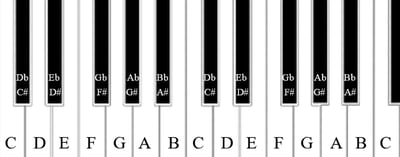

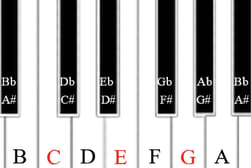

C MAJOR triad is made from the
combination of the notes C - E - G
A minor triad is made from the
combination of the notes A - C - E
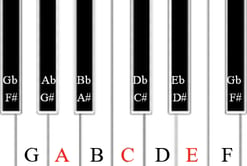

EXPLORE :
© 2025. All rights reserved. tooz & t, LLC
Spread the word via your favorite platform
ENGAGE :
KEEP IN TOUCH :
For General Questions and/or Wholesale Inquiries, please contact us directly by email : tntmusic@toozandt.com
For General Questions and/or Wholesale Inquiries, please contact us directly by email : tntmusic@toozandt.com